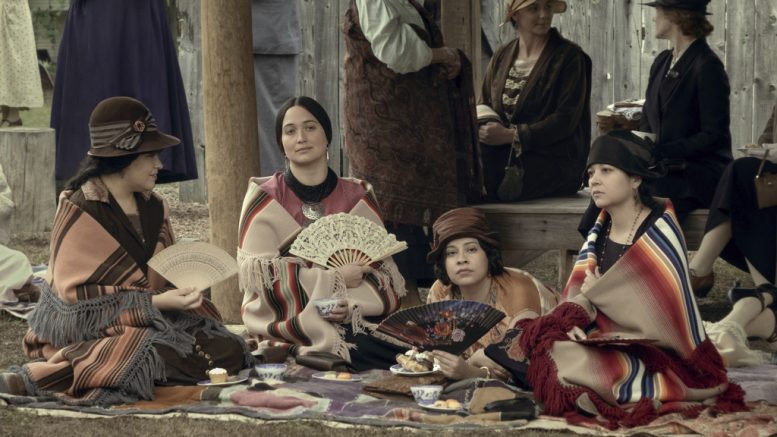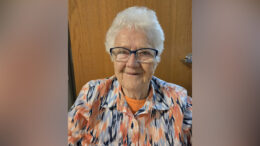The Associated Press
There tends to be lots of fast talking and fast moving in Martin Scorsese films, often from shifty types trying to get away with something. Or sometimes, simply because the master filmmaker has so much to pack in.
But in “Killers of the Flower Moon,” everything seems to slow down, and especially when the camera lands on Lily Gladstone. As Mollie, the Osage woman at the heart of this sprawling, real-life tale of greed and treachery on a scale both broad and intimate, Gladstone is the quiet, powerful center — taking her time, letting her eyes do the work, and unafraid of silence.
It’s a beautifully cadenced performance, all the more impressive because Gladstone’s sharing the screen with two of our most celebrated actors. Leonardo DiCaprio and Robert De Niro both turn in superb work for their legendary director, appearing together for the first time in 30 years. But Gladstone, in the rare Scorsese film that gives center stage to a female character, is the emotional core here, and it’s her face that stays etched in our memory.
Based on David Grann’s gripping whodunit set among the Osage in 1920s Oklahoma, “Killers” is a departure in other ways for the 80-year-old filmmaker. It’s his first Western, a genre he’s long wanted to explore — albeit a uniquely Scorsese Western, with an upended world of heroes and villains. And in telling this Osage story, he focuses on a people he’s never depicted before, deeply mindful of honoring their experience and their rituals, beliefs and customs.
It surely won’t surprise anyone that Scorsese brings his full wealth of artistic resources to this endeavor, along with his brilliant cinematographer, Rodrigo Prieto, and inspired production designer, Jack Fisk. Together, on location in Oklahoma, they’ve created an oil boomtown astonishing in its precision, detail and spirit.
It may also not surprise anyone that Scorsese has taken three and a half hours (albeit three minutes less than “The Irishman” ) to tell his tale. This may be a source of debate, but it’s hard to argue that a story this hefty — a chronicle of a dark chapter in American history and a shocking true crime tale, all framed in a fraught love story — doesn’t deserve the length, considering the craft in every shot. And with some scenes — a boisterous prairie wedding, or a dance on a boomtown main drag — you feel you could have stayed longer still.
We begin with a late 19th-century ceremony, one of many portrayals of Osage spiritual life. Then, in a memorable image, there’s a whoosh from underground: Oil, spurting from land that was supposed to be worthless.
Thanks to this discovery, we learn in a terrific prologue using silent-movie title cards, the Osage become enormously wealthy. But they’re deemed “incompetent” and appointed white “guardians” who control their assets. This is how we meet Mollie, asking for her own money to pay medical bills.
Meanwhile, Ernest Burkhart (DiCaprio) steps off the train, a World War I vet with a taste for women and finer things, but no money, or talent to speak of. Perhaps his uncle can help. William Hale (De Niro) is a cattle rancher but more like a king around these parts — indeed, King’s his nickname — a white man who speaks the Osage language and calls himself their best friend.
But it’s clear from the get-go Hale has sinister motives, and De Niro’s just the guy to ooze sinister from every pore as this Godfather-like figure (he commits crimes, and they’re organized). Scorsese and co-writer Eric Roth depart here from Grann’s book, which holds us in suspense as to Hale’s motives. He wants Osage money, and tells Ernest that if he woos and marries Mollie — well, even less-than-brilliant Ernest can do the math.
So can Mollie. Trusting but hardly naive, she knows Ernest covets her wealth, but there’s growing affection between the two, and their marriage, gorgeously rendered, is a happy occasion.
But then the Osage start dying, one by one, in suspicious ways — including, eventually, Mollie’s sisters and mother. As for Ernest, he’s no angel, spending time robbing and gambling. But is he doing more? DiCaprio’s mouth settles into a tortured frown as he becomes increasingly torn between marital loyalty and fealty to his venal uncle.
Finally, federal agent Tom White (Jesse Plemons, perfectly cast) shows up, working for J. Edgar Hoover in what became the FBI. (It’s White who figured most prominently in Grann’s book, and indeed DiCaprio was once slated to play him.) This last act finds its way to a crackling courtroom scene perhaps only Scorsese could bring together: jittery DiCaprio and menacing De Niro, joined by a bombastic Brendan Fraser and a sputtering John Lithgow.
Indeed, the vast supporting cast includes countless faces you may recognize, as well as cameos of a number of musicians, and dozens of Osage actors in key parts. Scorsese’s late friend Robbie Robertson wrote the memorable score.
We won’t spoil the ingenious epilogue in which Scorsese ties up the loose narrative ends — with another significant cameo. But the fact that this epilogue comes after, oh, 200 minutes of expertly sustained tension is just another sign that in the latter years of his career, Scorsese is upping the ante — in terms of scale, yes, but also ambition.
He has called his work an offering to the Osage, and to other Native peoples. It also feels like an offering to those who love cinema, allowing us to watch a master of the craft continue to force himself, unlikely as it seems, to stretch and learn. May he keep stretching — himself, and us.
“Killers of the Flower Moon,” an AppleTV+ release, has been rated R by the Motion Picture Association “for violence, some grisly images, and language.” Running time: 206 minutes. Four stars out of four.




































